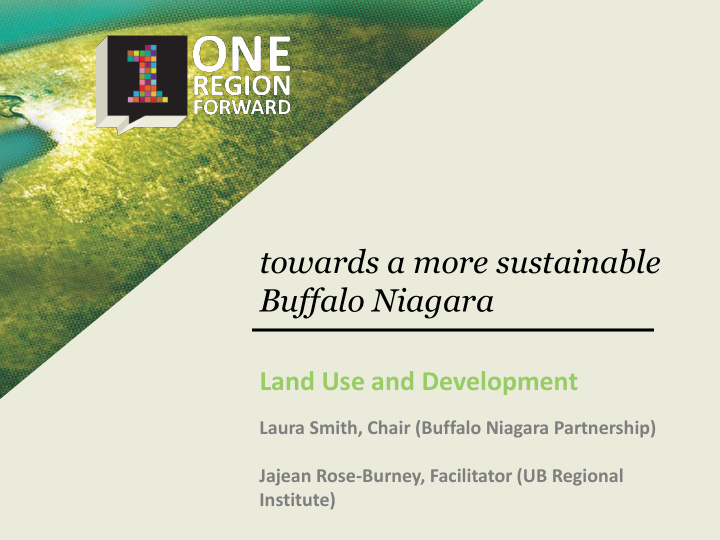



towards a more sustainable Buffalo Niagara Land Use and Development Laura Smith, Chair (Buffalo Niagara Partnership) Jajean Rose-Burney, Facilitator (UB Regional Institute)
Agenda Welcomes, introductions and review Working Team Housekeeping Bringing goals to “final draft” What might Buffalo Niagara look like in forty years? Strategy development discussion Next steps
we are creating a regional plan for Why sustainable development with a core regional strategy for our Land Use and Development… • Centerpiece of Federal policy shift aimed at coordinated planning for how regions use Federal dollars
we are creating a regional plan for Why sustainable development with a core regional strategy for our Land Use and Development… • Sprawl without population growth remains one of our biggest regional challenges • We lack the tools and platforms for coordinating strategies for smart growth
Working Team Process and Timeline
What Data Gaps to work on the Data Tells Us Major areas of research inquiry based on meeting #1 discussion • Demonstrated evidence of the positive impacts of smart growth policies, especially related to tax burden • A more complete description of WNY’s natural heritage • A more accurate picture of the vacant housing problem • Analyze the location and increase of vacant commercial spaces, not only housing • Reconsider the causes of the loss of agricultural land; development is not the only factor • A consideration of potential future population changes in terms of total population and demographics
What Data Gaps to work on the Data Tells Us Major areas of research inquiry based on meeting #1 discussion SOURCES: Urbanized Area: US Census Bureau. (2012). 2 010 Urbanized Area TIGER\Line Shapefile , Buffalo-Niagara Metropolitan Area. Water Bodies: U.S. Geological Survey. (2012). National Hydrography Dataset. Wetlands: US Fish & Wildlife Service. (2009). National Wetlands Inventory Polygons; N.Y. Department of Environmental Conservation. (2012). New York State Regulatory Freshwater Wetlands. Parks & Protected Areas: Erie County Department of Environment & Planning; (2012). Niagara County Department of Economic Development; (2011). Parcel Boundary Data .; NYS Office of Cyber Security. (2010). NYS Public Land Boundaries. Forest & Cropland Cover: U.S. Department of Agriculture, National Agricultural Statistical Survey, Research and Development Division, Geospatial Information Branch, Spatial Analysis Research Section. (2011). New York Cropland Data Layer.
What the Data Tells Us SOURCE: Brown University, Spatial Structures in the Social Sciences. (2010). US2010 Project, Longitudinal Tract Data Base. US Decennial Census Data 1970-2010 . U.S. Census Bureau. (2010). TIGER/Line Shapefile, New York, 2010 Census Tract State-based.
What the Data Tells Us SOURCE: Brown University, Spatial Structures in the Social Sciences. (2010). US2010 Project, Longitudinal Tract Data Base. US Decennial Census Data 1970-2010 . U.S. Census Bureau. (2010). TIGER/Line Shapefile, New York, 2010 Census Tract State-based.
Draft Goals: Land Use and Development (1/2) Focus development in areas already served by infrastructure especially in urban cores, corridors, and village centers. Promote the adaptive reuse of commercial, industrial, and ecclesiastical building stock to preserve embedded energy, neighborhood integrity, and heritage. Minimize the conversion of natural areas, rural and agricultural land to development. Coordinate investments in transportation infrastructure with plans for development and redevelopment. Manage land use to restore or protect our water, water rights, and watersheds.
Draft Goals: Land Use and Development (2/2) Repair the toxic damage left by our industrial past and make land ready for appropriate future reuse Protect or restore our waterfronts , connect them to local communities and make them more accessible to the public. Maintain, improve, expand, and connect our parks, recreation areas, trails and open spaces
One Region Forward challenges us to decide what kind of change we desire What will life in Buffalo Niagara look like in forty years? 2014 2050 2053 2013 2020 2038 2046 2035 2040 2015
Brainstorming strategies for action for long-term sustainability in Buffalo Niagara What might our region look like in 2050 if our region’s population… …continues to …sees moderate … grows shrink growth? significantly?
Brainstorming strategies for action for long-term sustainability in Buffalo Niagara Under alternative futures, what might our region look like in 40 years depending on future development patterns? What will our cities, villages, and main streets look like? Where will our farms, natural areas and other open spaces be? How How will people get to much will we have? work, and how long will it take? How will climate change impact land use and Will smart growth policies be development? different or the same, given different population growth possibilities?
Strategy Development : A simple framing question What should we, as a region, do today and in the future, to create more sustainable forms of development and land uses? A reminder on our distributed implementation model: Local municipalities, county Private sector actors or governments, state or regional businesses (developers, agencies business decision-makers) Collaborative partnerships Community Based Organizations across these groups and private citizens
Land Use and Development Working Team Get Started as a Working Team Member at www.oneregionforward.org Recruit a Working Provide Online Feedback on Team Contributor Our Regional Vision and Values
Help tell the story of how we’re defining sustainability in Buffalo Niagara
TeamWork Site: https://oneregionforward.teamworkpm.net
TeamWork Site: https://oneregionforward.teamworkpm.net
Land Use and Development Working Team If you have any questions, please feel free to contact us Bart Roberts Teresa Bosch de Celis One Region Forward One Region Forward Project Project Manager Assistant bjr8@buffalo.edu tboschde@buffalo.edu
Recommend
More recommend